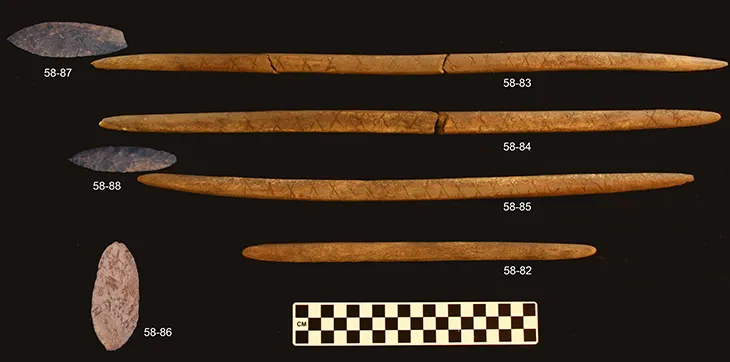Ice Age Babies Surrounded by Weapon Parts Found in Alaska
Unearthed at an ancient hunting camp in Alaska, the infant remains are offering clues to the burial rites of early Americans
:focal(653x351:654x352)/https://tf-cmsv2-smithsonianmag-media.s3.amazonaws.com/filer/c8/97/c8975af1-6105-4ec5-bc31-b1ae6464791e/excavation_detailedit.jpg)
Around 11,500 years ago, a band of hunters buried two human babies in a pit in what is now Alaska. Surrounded by components of ancient weapons, the skeletons are giving archaeologists a unique look at cultural practices at the end of the last Ice Age, when people began to colonize North America.
“Prior to these finds, we really did not have evidence of that facet of settlement and traditional systems for the early Americans who once inhabited this area,” says Ben Potter, an archaeologist at the University of Alaska in Fairbanks. “These are new windows into these ancient peoples’ lifestyle.”
In 2006, a survey for a railroad project turned up an archaeological site north of the Tanana River in central Alaska. Four years later, Potter and his colleagues excavated the area and uncovered the partially cremated remains of a three-year-old in the hearth of a subterranean house built 11,500 years ago.
The Upward Sun River site, as it’s now called, was likely occupied by the Denali people who inhabited central Alaska from 12,000 to 6,000 years ago, toward the end of the Pleistocene epoch, often referred to as the last Ice Age. Back then the environment would have been cold and dry, but it was getting a little warmer and wetter as the global climate thawed out. Spruce trees had not yet invaded the Alaskan landscape, but—like local residents today—these ancient humans did a lot of salmon fishing.
Potter’s team expanded their excavation in 2013, working with local tribal groups. Almost 16 inches directly below the three-year-old, they found more bone fragments. “At the time of discovery, all we could say is that they looked human, and they looked quite small,” recalls Potter. Tooth and bone analysis revealed that the team had uncovered two sets of remains: an infant that died at least six weeks after birth and a fetus, possibly stillborn. Pelvis shape in both infants suggests that they may have been female. The fetus represents the youngest late Pleistocene individual yet discovered, the researchers report today in the Proceedings of the National Academy of Sciences (PNAS).
You can learn a lot about people from how they bury their dead. In this case, the infant remains appear to have been curled up, wrapped and covered in red ochre. Unlike the cremated child above them, ritual objects that date to around 11,600 to 11,230 years ago surrounded the infants—antler rods, projectile points and sharpened stones called bifaces, all decorated with red ochre as well. The researchers hypothesize that such implements could have been parts of a weapon system: the antler rods may have served as spear or dart foreshafts that attached to the points. “These weren’t just created and placed there,” says Potter. "Together, they form a functional hunter’s toolkit."

Based on the wear and tear on the items, people had used them, but they weren’t broken. Burying them with the babies represents a certain level of sacrifice. “While the artifacts left behind were functional tools and materials need to survive, they were still left with the children. This bespeaks of the deep sense of loss and sorrow these people must have felt at the loss of their children,” notes Michael Waters, an archaeologist at Texas A&M University who was not affiliated with the study.
Clearly, hunting was of vital importance to these people, and probably to the first Americans more generally. As hunting parties roamed the area, they likely processed their food at sites like this one. But such a nomadic lifestyle built around large game hunting isn’t without risks. “Life was tough for these early people, and they suffered losses along the way in their quest to colonize the Americas,” says Waters.
The newfound burials also create a little mystery: Why were the two infants buried intact while the third child was cremated? Archaeological artifacts found in both excavation layers suggest that the children belonged to the same culture. It could be a seasonal difference, as digging a burial pit in winter is harder than in summer. Or a prominent family member might have been absent when the three-year-old died, causing the family to choose a simpler cremation. It's also possible these early North Americans treated the dead differently based on age. Without other local burials to compare the finds, it’s impossible to say.
Infants are rare in the archaeological record, but they’ve proved critical in learning about the peopling of North America. The style of the Alaska burial is similar to other infant burials at a Clovis site in Montana and a site on Ushki Lake in Siberia. That’s not too surprising, given that other Denali sites bear similarity to those of the Dyuktai culture, which originated in Siberia and crossed an ancient land bridge from Beringia to North America. Further genetic analysis might reveal how closely these children are related to each other and to other early North American people.
Potter’s team is currently pursuing that line of evidence. If they can extract DNA from the infant bones, it could clear up some big questions, says Waters: “It would help resolve issues about who the Ice Age people living in eastern Beringia were related to and how they fit into the puzzle of the peopling of the Americas south of the ice sheets.”
/https://tf-cmsv2-smithsonianmag-media.s3.amazonaws.com/accounts/headshot/Screen_Shot_2014-01-27_at_12.05.16_PM.png)
/https://tf-cmsv2-smithsonianmag-media.s3.amazonaws.com/accounts/headshot/Screen_Shot_2014-01-27_at_12.05.16_PM.png)